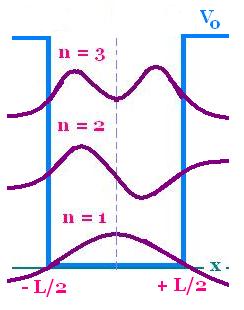Quantum Mechanics
Schrodinger equation
Quantum Mechanics
Propagators : Pg
Quantum Simple Harmonic
Oscillator QSHO
Quantum Mechanics
Simulation With GNU Octave
© The scientific sentence. 2010
|
|
Free Particle in a finite-walled box of length L
Finit well
The Schrödinger time-dependant equation is :
iℏ ∂ψ(r,t)/∂t = - (ℏ 2/2m)∂2ψ(r,t)/∂r2 + V(r) ψ(r,t)
The energy values E of the particle are less than the value of potential energy
for this finite potential well: E < Vo.
We have two regions:
1. Where the particle is free: - L/2 < x < + L/2 , V(x) = 0
2. Where the particle is linked by a constant potential V(x) Vo :
- ∞ < x< - L/2 and + L/2 < x < ∞
Within the first region, the solution of the Schrödinger time-dependant equation
is the one of the free-particle wavefunction:
ψ(r,t) = A exp{ikr - i ωt}
Within the second region, the Schrödinger time-independant equation is the
following:
- (ℏ 2/2m)∂2ψ(r)/∂r2 + Vo ψ(r) = E ψ(r), Or:
∂2ψ(r)/∂r2 + [2m(E - Vo)/ (ℏ 2)]ψ(r) = 0
Equation of the form:
∂2ψ(r)/∂r2 - α2 ψ(r) = 0
where α2 = 2m(Vo - E)/ (ℏ 2)
This equation has the solution of the form:
ψ(r) = A exp{αr} + B exp{- αr}
For a finite potential well, the solution to the Schrodinger equation
is a wavefunction that gives an exponentially decaying
penetration into the classicallly forbidden region. This is because in Classical
Physics, we can not have a value of potential Vo greater that the
total energie E (value of the Hamiltonian).
In Quantum Mechanics, V(x) is the potential wherein the
particule moves, not the one of the particle itself.

|
|